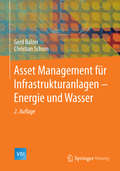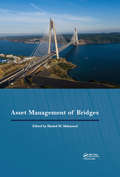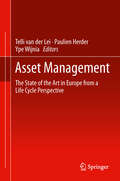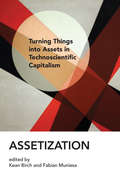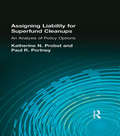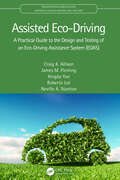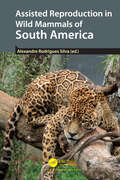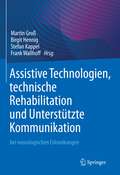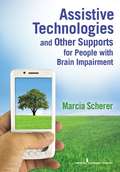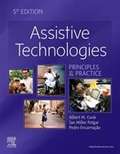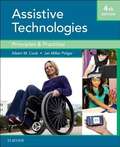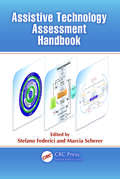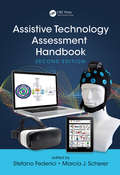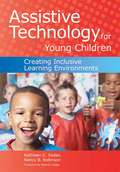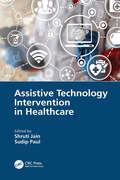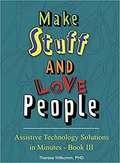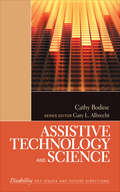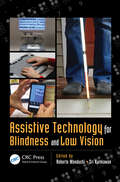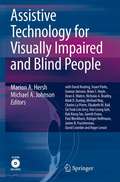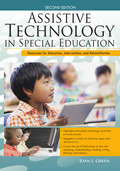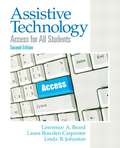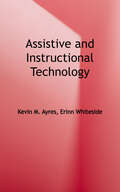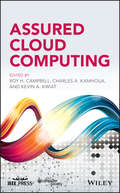- Table View
- List View
Asset Management für Infrastrukturanlagen - Energie und Wasser (VDI-Buch)
by Gerd Balzer Christian SchornDie Aufgabe eines Versorgungsunternehmens besteht darin, seine Kunden zuverlässig mit Elektrizität, Gas oder Wasser zu versorgen. Um diese Aufgabe in einem regulierten Markt zu erfüllen, können Versorgungsunternehmen neue Strukturen und Verfahren entwickeln. Damit sie dabei sowohl den Eigentümern als auch der Regulierungsinstanz gerecht werden, ist es sinnvoll, bisherige Prozesse neu zu strukturieren. Die Autoren liefern einen umfassenden Überblick zu Asset-Management-Prozessen, die derzeit in Versorgungsunternehmen umgesetzt werden.
Asset Management of Bridges: Proceedings of the 9th New York Bridge Conference, August 21-22, 2017, New York City, USA
by Khaled M. MahmoudMaintaining bridges in good condition has extended service life and proven to be more cost effective than allowing degradation to advance, necessitating costlier bridge rehabilitation or replacement projects. Preventive maintenance is therefore an important tool to retard deterioration and sustain the safe operation of bridges. This includes a continuous effort of periodic inspections, condition evaluations and prioritizing repairs accordingly. The above measures define the framework for asset management of bridges. On August 21-22, 2017, bridge engineering experts from around the world convened at the 9th New York City Bridge Conference to discuss issues of construction, design, inspection, monitoring, preservation and rehabilitation of bridge structures. This volume documents their contributions to the safe operation of bridge assets.
Asset Management: The State of the Art in Europe from a Life Cycle Perspective (Topics in Safety, Risk, Reliability and Quality)
by Ype Wijnia Paulien Herder Telli Van der LeiIn the past decades asset intensive companies have witnessed a number of regulatory changes and especially industry is facing ever increasing competitiveness. To overcome these challenges different asset management methods have been developed aimed to improve the asset life cycle. Especially the design phase and operation and maintenance phase have seen a rise in tools and methods. Smarter design can lead to improved operation. Likewise, improved operation and maintenance leads to lower replacement costs and may provide the basis for better design. This book brings together and coherently presents the current state of the art in asset management research and practice in Europe from a life cycle perspective. Each chapter focuses on specific parts of this life cycle and explains how the methods and techniques described are connected and how they improve the asset life cycle, thus treating this important subject from a unique perspective.
Assetization: Turning Things into Assets in Technoscientific Capitalism (Inside Technology)
by Kean Birch Fabian MuniesaHow the asset--anything that can be controlled, traded, and capitalized as a revenue stream--has become the primary basis of technoscientific capitalism.In this book, scholars from a range of disciplines argue that the asset--meaning anything that can be controlled, traded, and capitalized as a revenue stream--has become the primary basis of technoscientific capitalism. An asset can be an object or an experience, a sum of money or a life form, a patent or a bodily function. A process of assetization prevails, imposing investment and return as the key rationale, and overtaking commodification and its speculative logic. Although assets can be bought and sold, the point is to get a durable economic rent from them rather than make a killing on the market.
Assigning Liability for Superfund Cleanups: An Analysis of Policy Options
by Paul R. Portney Katherine N. ProbstWhile more than 2,700 emergency removals of hazardous materials have taken place under Superfund, implementing the long-term cleanup program has been the object of considerable controversy. One of the most contentious issues is whether the liability standards in the law should be revised. The authors analyze the pros and cons associated with the current liability approach, as well as with a variety of alternative strategies.
Assisted Eco-Driving: A Practical Guide to the Design and Testing of an Eco-Driving Assistance System (EDAS) (Transportation Human Factors)
by Neville A. Stanton Craig K. Allison James M. Fleming Xingda Yan Roberto LotThis book discusses an integrative approach combining Human Factors expertise with Automotive Engineering. It develops an in-depth case study of designing a fuel-efficient driving intervention and offers an examination of an innovative study of feed-forward eco-driving advice. Assisted Eco-Driving: A Practical Guide to the Design and Testing of an Eco-Driving Assistance System offers an examination of an innovative study of feed-forward eco-driving advice based on current vehicle and road environment status. It presents lessons, insights and utilises a documented scientific and research-led approach to designing novel speed advisory and fuel use minimisation systems suitable for combustion vehicles, hybrids and electric vehicles The audience consists of system designers and those working with interfaces and interactions, UX, human factors and ergonomics and system engineering. Automotive academics, researchers, and practitioners will also find this book of interest.
Assisted Reproduction in Wild Mammals of South America
by Alexandre Rodrigues SilvaSouth America has one of the greatest riches in the world in terms of biodiversity. Despite all this richness, recent reports warn of different threats to this biodiversity. As a strategy to reduce the rate of loss of animal species, the development and application of assisted reproduction techniques (ARTs) for their conservation currently stands out. Thus, this book compiles information on recent scientific studies regarding the development of ARTs for the conservation of wild mammalian species in South America, thus serving as an important source of reference for professionals and students interested in wildlife conservation.
Assistive Augmentation (Cognitive Science and Technology)
by Jochen Huber Roy Shilkrot Pattie Maes Suranga NanayakkaraThis book addresses Assistive Augmentation, highlighting the design and development of assistive technologies, user interfaces, and interactions that seamlessly integrate with a user's mind, body, and behavior, providing an enhanced perception. Our senses are the dominant channel we use to perceive the world around us. Whether they have impairments or not, people often find themselves at the limits of their sensorial capabilities. Some seek assistive or enhancing devices that enable them to carry out specific tasks or even transform them into a "superhuman" with capabilities well beyond the ordinary. The overarching topic of this book revolves around the design and development of technologies and interfaces that provide enhanced physical, sensorial and cognitive capabilities: "Assistive Augmentation". The Assistive Augmentation community convened at an interdisciplinary workshop at the 2014 International Conference on Human Factors in Computing Systems (CHI) in Toronto, Canada. The community is comprised of researchers and practitioners who work at the junction of human-computer interaction, assistive technology and human augmentation. This edited volume, which represents the first tangible outcome of the workshop, presents stimulating discussions on the challenges of Assistive Augmentation as examined through case studies. These studies focus on two main areas: (1) Augmented Sensors and Feedback Modalities, and (2) Design for Assistive Augmentation.
Assistive Technologien, technische Rehabilitation und Unterstützte Kommunikation: bei neurologischen Erkrankungen
by Martin Groß Birgit Hennig Stefan Kappel Frank WallhoffDas interdisziplinäre Grundlagenwerk informiert aus der Perspektive von Neurologie, Rehabilitation, Ingenieurwesen, Pädagogik und Physiotherapie sowie aus Sicht der Patienten über Möglichkeiten und Grenzen des Einsatzes von Technik, um die Teilhabe neurologisch erkrankter Menschen zu verbessern. Ziel des Buches ist, allen Berufsgruppen, die an der Behandlung schwer und komplex erkrankter neurologischer Patienten beteiligt sind, ein umfassendes Verständnis assistiver und rehabilitativer Technologien zu vermitteln.
Assistive Technologies and Other Supports for People With Brain Impairment
by Marcia J. SchererAssistive Technologies and Other Support for People with Brain Impairment, by Marcia J. Scherer, is a must-have text for academic instructors and their students. The author's synopsis of brain impairment, current rehabilitation strategies, available assistive technologies and resources, as well as the practical merging of the above, makes this an invaluable addition to any academic program in cognitive rehabilitation. This book gives a clear and detailed overview of how the brain reacts to impairment and gives illustrated examples of effective integration of AT into the lives of people with cognitive disability. Integrating current research with the experiences of people with cognitive disabilities, this volume examines how assistive and cognitive support technologies are being harnessed to provide assistance for thinking, remembering, and learning. The book vividly describes real-life situations in which cognitively impaired individuals use assistive supports and the advantages and limitations these individuals perceive from their use. It provides information on how cognitively impaired individuals and their families and caregivers can select the most appropriate technologies from a wide array of accommodations and resources, including individualized protocols of different forms of support to facilitate optimal functioning. The text offers practitioners a comprehensive and systematic process for ensuring their clients' effective application and utilization of this technology. This book will also provide insight for users of assistive technology and their families and caregivers to ensure optimal technology use.
Assistive Technologies: Principles And Practice
by Albert M. Cook Janice Miller Polgar Pedro EncarnaçãoMaster the assistive strategies you need to make confident clinical decisions and help improve the quality of life for people with disabilities. Based on the Human Activity Assistive Technology (HAAT) model developed by Al Cook, Sue Hussey and Jan Polgar, Assistive Technologies: Principles & Practice, 5th Edition, provides detailed coverage of the broad range of devices, services, and practices that comprise assistive technology. This new text offers a systematic process for ensuring the effective application of assistive technologies - and focuses on the relationship between the human user and the assisted activity within specific contexts. It features over 30 new photos and illustrations, as well as, updated chapters and case studies that reflect current technology.
Assistive Technologies: Principles And Practice
by Albert M. Cook Janice Miller PolgarIt's here: the latest edition of the one text you need to master assistive strategies, make confident clinical decisions, and help improve the quality of life for people with disabilities. Based on the Human Activity Assistive Technology (HAAT) model, Assistive Technologies: Principles and Practice, 4th Edition provides detailed coverage of the broad range of devices, services, and practices that comprise assistive technology, and focuses on the relationship between the human user and the assisted activity within specific contexts. Updated and expanded, this new edition features coverage of new ethical issues, more explicit applications of the HAAT model, and a variety of global issues highlighting technology applications and service delivery in developing countries. Human Activity Assistive Technology (HAAT) framework demonstrates assistive technology within common, everyday contexts for more relevant application. Focus on clinical application guides you in applying concepts to real-world situations. Review questions and chapter summaries in each chapter help you assess your understanding and identify areas where more study is needed. Content on the impact of AT on children and the role of AT in play and education for children with disabilities demonstrates how AT can be used for early intervention and to enhance development. Coverage of changing AT needs throughout the lifespan emphasizes how AT fits into people's lives and contributes to their full participation in society. Principles and practice of assistive technology provides the foundation for effective decision-making. NEW! Global issues content broadens the focus of application beyond North America to include technology applications and service delivery in developing countries. NEW! Ethical issues and occupational justice content exposes you to vital information as you start interacting with clients. NEW! More case studies added throughout the text foster an understanding of how assistive technologies are used and how they function. NEW! Updated content reflects current technology and helps keep you current. NEW! Explicit applications of the HAAT model in each of the chapters on specific technologies and more emphasis on the interactions among the elements make content even easier to understand.
Assistive Technology Assessment Handbook (Rehabilitation Science in Practice Series)
by Marcia J. Scherer Stefano FedericiThe process of matching a person who has a disability with the most appropriate assistive technology requires a series of assessments, typically administered by multidisciplinary teams at specialized centers for technical aid. Assistive Technology Assessment Handbook fills the need for a reference that helps assistive technology experts perform ass
Assistive Technology Assessment Handbook (Rehabilitation Science in Practice Series)
by Marcia Scherer Stefano FedericiAssistive Technology Assessment Handbook, Second Edition, proposes an international ideal model for the assistive technology assessment process, outlining how this model can be applied in practice to re-conceptualize the phases of an assistive technology delivery system according to the biopsychosocial model of disability. The model provides reference guidelines for evidence-based practice, guiding both public and private centers that wish to compare, evaluate, and improve their ability to match a person with the correct technology model. This second edition also offers a contribution to the Global Cooperation on Assistive Technology (GATE) initiative, whose activities are strongly focused on the assistive products service delivery model. Organized into three parts, the handbook: gives readers a toolkit for performing assessments; describes the roles of the assessment team members, among them the new profession of psychotechnologist; and reviews technologies for rehabilitation and independent living, including brain–computer interfaces, exoskeletons, and technologies for music therapy. Edited by Stefano Federici and Marcia J. Scherer, this cross-cultural handbook includes contributions from leading experts across five continents, offering a framework for future practice and research.
Assistive Technology For Young Children: Creating Inclusive Learning Environments
by Kathleen Curry Sadao Nancy B. RobinsonThis book appeals to the needs of a wide range of readers who seek to increase their technology competencies in order to improve access to learning for children with disabilities.
Assistive Technology Intervention in Healthcare
by Sudip Paul Shruti JainAssistive Technology Intervention in Healthcare focuses on various applications of intelligent techniques in biomedical engineering and health informatics. It aims to create awareness about disability reduction and recovery of accidental disability with the help of various rehabilitative systems. Novel technologies in disability treatment, management and assistance, including healthcare devices and their utility from home to hospital, are described. The book deals with simulation, modeling, measurement, control, analysis, information extraction and monitoring of physiological data in clinical medicine and biology. Features Covers the latest evolutionary approaches to solve optimization problems in the biomedical engineering field Explains machine learning–based approaches to improvement in health engineering areas Reviews the IoT, cloud computing and data analytics in healthcare informatics Discusses modeling and simulations in the design of biomedical equipment Explores monitoring of physiological data This book is aimed at researchers and graduate students in biomedical engineering, clinical engineering and bioinformatics.
Assistive Technology Solutions in Minutes Book III - Make Stuff and Love People
by Therese WillkommThis book is about the joy of creating and making thousands of different assistive technology solutions to maximize independence at home, workplace, school, and communities for individuals who experience various limitations. It is the most comprehensive Assistive Technology (AT) Makers book I’ve ever written. I filled it with over 1500 images including over 500 QR codes for instant access to short YouTube videos and resources showing how to make the various AT devices. The first chapter focuses on tools, materials, and techniques for the rapid fabrication of assistive technology solutions using low-cost/no-cost materials; the last chapter provides QR Code access to the tools, materials and resources described throughout the book. The chapters in between focus on the solutions and devices or modifications for smartphones, iPads; mobility impairments; self-care; eating and drinking; reading and writing; reaching and holding; communicating; solutions for blind and low vision; and assistive technology ideas for leisure and play.
Assistive Technology and Science (The SAGE Reference Series on Disability: Key Issues and Future Directions)
by Cathy BodineThis volume in The SAGE Reference Series on Disability explores issues involving assistive technology engineering and science. It is one of eight volumes in the cross-disciplinary and issues-based series, which incorporates links from varied fields making up Disability Studies as volumes examine topics central to the lives of individuals with disabilities and their families. With a balance of history, theory, research, and application, specialists set out the findings and implications of research and practice for others whose current or future work involves the care and/or study of those with disabilities, as well as for the disabled themselves. The presentational style (concise and engaging) emphasizes accessibility. Taken individually, each volume sets out the fundamentals of the topic it addresses, accompanied by compiled data and statistics, recommended further readings, a guide to organizations and associations, and other annotated resources, thus providing the ideal introductory platform and gateway for further study. Taken together, the series represents both a survey of major disability issues and a guide to new directions and trends and contemporary resources in the field as a whole.
Assistive Technology for Blindness and Low Vision (Rehabilitation Science in Practice Series)
by Roberto Manduchi Sri KurniawanAssistive technology has made it feasible for individuals with a wide range of impairments to engage in many activities, such as education and employment, in ways not previously possible. The key factor is to create consumer-driven technologies that solve the problems by addressing the needs of persons with visual impairments. Assistive Technology for Blindness and Low Vision explores a broad range of technologies that are improving the lives of these individuals. Presenting the current state of the art, this book emphasizes what can be learned from past successful products, as well as what exciting new solutions the future holds.Written by world-class leaders in their field, the chapters cover the physiological bases of vision loss and the fundamentals of orientation, mobility, and information access for blind and low vision individuals. They discuss technology for multiple applications (mobility, wayfinding, information access, education, work, entertainment), including both established technology and cutting-edge research. The book also examines computer and digital media access and the scientific basis for the theory and practice of sensory substitution.This volume provides a holistic view of the elements to consider when designing assistive technology for persons with visual impairment, keeping in mind the need for a user-driven approach to successfully design products that are easy to use, well priced, and fill a specific need. Written for a broad audience, this book provides a comprehensive overview and in-depth descriptions of current technology for designers, engineers, practitioners, rehabilitation professionals, and all readers interested in the challenges and promises of creating successful assistive technology.
Assistive Technology for Visually Impaired and Blind People
by Marion A. Hersh Michael A. JohnsonEqual accessibility to public places and services is now required by law in many countries. In the case of the vision-impaired, it is often the use of specialised technology which can provide them with a fuller enjoyment of all the facilities of society from large scale meetings and public entertainments to the more personal level of reading a book or making music. In this volume the engineering and design principles and techniques used in assistive technology for blind and vision-impaired people are explained. Features:· instruction in the physiology of the human visual system and methods of measuring visual ability;· explanation of many devices designed for every-day living in terms of generic electrical engineering principles;· sections of practical projects and investigations which will give the reader ideas for student work and for self teaching;· contributions by authors of international repute from divers fields which co-operate under the banner of assistive technology, among them: artificial vision systems; psychology, haptics, electrical engineering, design and visual physiology. Assistive Technology for Vision-impaired and Blind People is an an effective means of maintaining the currency of knowledge for engineers and health workers working to provide devices and/or services for people with sight loss and an excellent source of reference for students working in assistive technology and rehabilitation.
Assistive Technology in Special Education: Resources for Education, Intervention, and Rehabilitation
by Joan GreenFamilies, teachers, and therapists who are searching for an update about how to use the latest technologies to help individuals who struggle with communication, literacy, and learning will benefit from the wealth of practical, well-organized information in this second edition of Assistive Technology in Special Education. The indexed update presents an overview of the uses of technologies to help readers zero in on specific, powerful, cutting-edge resources they can use to enhance success. The book features new tools to improve and compensate for challenges relating to speaking, understanding, reading, writing, thinking and remembering, as well as strategies to help students become more organized and efficient. The use of tablets such as the iPad and smartphones, as well as cloud-based products, are highlighted. Online resources and social networking tools are presented to empower readers to learn about new products as they become available.
Assistive Technology in the Classroom: Enhancing the School Experiences of Students With Disabilities (Second Edition)
by Amy G. Dell Deborah A. Newton Jerry G. PetroffThe book takes a look at the most effective uses of assistive technology for students with disabilities that emphasizes the link between technology and learning.
Assistive Technology: Access For All Students
by Lawrence A. Beard Linda B. Johnston Laura Bowden CarpenterOrganized around the theme of universal design, this guide to assistive technology discusses the knowledge and skills educators need to know in order to determine the appropriate use of technology and services to meet the needs of individuals with disabilities. The text provides an overview and introduction to the topic of assistive technology, evaluating various technologies for classroom use, and using assistive technology with special needs students of a diverse range of disabilities, including the young child with special needs, students with high incidence disabilities, positioning and mobility for students with physical disabilities, students with communication disorders, and sensory impairments. It further discusses AT in relation to transitioning, distance learning, and the ethical standards of practice. The new edition has been thoroughly updated to reflect the most recent AT beneficial to students requiring such special accommodations, including links to websites of current AT devices, and software for use in the classroom, and a new chapter on Universal Design for Learning and Response to Intervention and how to combine the two techniques to provide students with access to the general education curriculum. This edition also features more on ethics and assistive technology use for consideration of all students, new chapter introductions, questions for reflection, end-of-chapter review material, and extended coverage of diversity related to assistive technology and the classroom. Designed to provide useful information and strategies for candidates in teacher education programs and those practicing educators, the book is also useful to and any other professional or layperson interested in assistive technology and learning for all students.
Assistive and Instructional Technology
by Kevin M. Ayres Erinn WhitesideAssistive and Instructional Technology is a guide to using technology in the classrooms of students with autism spectrum disorder. This book describes the difference between assistive and instructional technology and how they are related. It identifies key features to look for in new technology and provides step-by-step support for using it effectively. This succinct resource describes critical aspects of current technology that result in improved learning outcomes.
Assured Cloud Computing
by Roy H. Campbell Charles A. Kamhoua Kevin A. KwiatExplores key challenges and solutions to assured cloud computing today and provides a provocative look at the face of cloud computing tomorrow This book offers readers a comprehensive suite of solutions for resolving many of the key challenges to achieving high levels of assurance in cloud computing. The distillation of critical research findings generated by the Assured Cloud Computing Center of Excellence (ACC-UCoE) of the University of Illinois, Urbana-Champaign, it provides unique insights into the current and future shape of robust, dependable, and secure cloud-based computing and data cyberinfrastructures. A survivable and distributed cloud-computing-based infrastructure can enable the configuration of any dynamic systems-of-systems that contain both trusted and partially trusted resources and services sourced from multiple organizations. To assure mission-critical computations and workflows that rely on such systems-of-systems it is necessary to ensure that a given configuration does not violate any security or reliability requirements. Furthermore, it is necessary to model the trustworthiness of a workflow or computation fulfillment to a high level of assurance. In presenting the substance of the work done by the ACC-UCoE, this book provides a vision for assured cloud computing illustrating how individual research contributions relate to each other and to the big picture of assured cloud computing. In addition, the book: Explores dominant themes in cloud-based systems, including design correctness, support for big data and analytics, monitoring and detection, network considerations, and performance Synthesizes heavily cited earlier work on topics such as DARE, trust mechanisms, and elastic graphs, as well as newer research findings on topics, including R-Storm, and RAMP transactions Addresses assured cloud computing concerns such as game theory, stream processing, storage, algorithms, workflow, scheduling, access control, formal analysis of safety, and streaming Bringing together the freshest thinking and applications in one of today’s most important topics, Assured Cloud Computing is a must-read for researchers and professionals in the fields of computer science and engineering, especially those working within industrial, military, and governmental contexts. It is also a valuable reference for advanced students of computer science.
